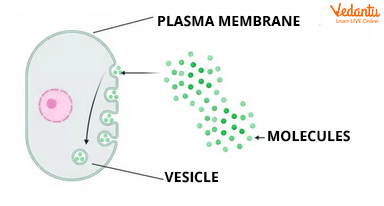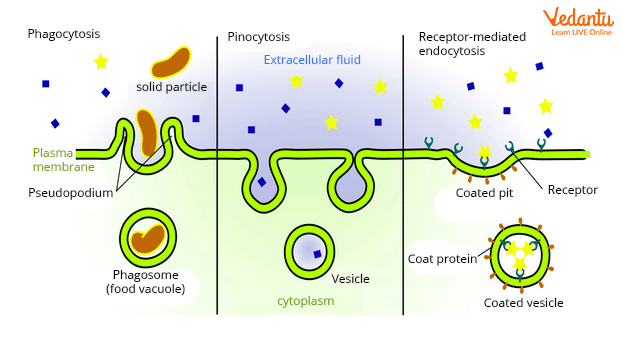




Endocytosis: An Introduction
Endocytosis is a process in which a cell takes up a substance from the outside by enclosing it with vesicles. It was first proposed by Du Duve in 1963. Pathogens that devour and destroy immune cells are among them, as are nutrients that support cells.
Endocytosis is a biological process that involves the introduction of a material into a cell. The internal material is encased by the cell membrane area, which subsequently creates a bladder to hold the intracellularly budded and trapped material. A section of the cell membrane folds around extracellular fluid, chemicals, and microbes in this area. The vesicles that form break apart and are carried inside the cell.
What is Endocytosis?
The cell membrane folds, forming a cavity filled with extracellular fluid, dissolved molecules, food particles, foreign matter, pathogens, and/or other substances, a process known as invagination.
Following invagination, the cell membrane folds back on itself to form an evenly enclosed membrane surrounding the trapped molecules, which is referred to as a vesicle. Some cells produce extension channels in the cytoplasm.
The newly generated vesicle separates from the cell membrane and is processed by the cell.

Image: Endocytosis Diagram
Endocytosis Example
Cholesterol is a necessary component of the plasma membrane of the cell and also serves as a hormone precursor. The cholesterol is subsequently transported to other cells in the body via a lipoprotein complex (such as LDL or low-density lipoprotein). An LDL receptor on the cell surface contacts the LDL complex to start the endocytic process. The Endoplasmic Reticulum (ER) generated these receptors, which were then transported and processed in the Golgi.
Clathrins, along with other proteins that participate in the process, are recruited once the receptor is attached to the complex on the cell's surface. Clathrin-coated pits are formed when receptors cluster together. The covered pits are pinched off and uncoated, generating endocytic vesicles. The vesicle is transferred to an endosome after it has been uncoated. The low pH of the endosome promotes a conformational shift that allows the LDL particles to escape. The cholesterol is subsequently released into the cell after these particles are sent to the lysosome for breakdown.
Types of Endocytosis: Phagocytosis, Pinocytosis, and Receptor-Mediated Endocytosis

Image: Different types of Endocytosis
Phagocytosis
The process by which a cell's cell membrane extends toward a particle, engulfing it and enclosing it behind a folded membrane to form a phagosome. Phagocytosis is a pathogen-elimination technique used by White blood cells (macrophages, monocytes, neutrophils, eosinophils, and dendritic cells) in multicellular organisms.
Phagocytosis Occurs in Five Stages:
The phagocytic cells identify an antigen or a molecule of interest and migrate towards it.
The phagocyte then attaches itself to the antigen or target molecule. Phagocytes can extend their membrane (pseudopodia) to the pathogen's target particle and surround it. While encapsulating the particles, the pseudopodia stretch towards each other.
The particle is then contained by the vesicle created by the fused extended pseudopodia. A phagosome is a vesicle that contains encapsulated particles. This is the vesicle that the phagocyte digests.
The phagosome joins the phagocyte's lysosomes to produce a phagolysosome. Digestive enzymes in the lysosomes degrade or digest the contents contained in the vesicle.
Exocytosis is used to evacuate the degraded particles from the phagocytic cell.
Pinocytosis
Cell drinking, also known as fluid endocytosis, is a type of endocytosis in which minute particles from external fluids invaginate the cell membrane, generating a small vesicle with suspended small molecules or particles within the cell. For particle digestion, the pinocytic vesicle joins with the cell endosome.
Two Processes Cause Pinocytosis:
Micropinocytosis is the creation of small vesicles with a diameter of around 0.1 µm in body cells, resulting in caveolae, which are tiny budding vesicles on the cell membrane. They're present in the endothelium of blood vessels. The large vesicles are formed by the cell membrane ruffles (villi), which are projections that extend to the extracellular fluids and can fold back on their own.
Macropinocytosis is the formation of larger vesicles of about 0.5-5µm in diameter; they are found on white blood cells. They shovel some extracellular fluid into the cell while folding, generating a vesicle that draws into the cell.
Receptor-Mediated Endocytosis
Receptor-mediated endocytosis is a kind of endocytosis in which receptor proteins on the cell surface capture a specific target molecule.
The receptors, which are transmembrane proteins, concentrate on the plasma membrane in covered pits.
When receptors bind to a specific target molecule, endocytosis begins, and the receptors and their attached molecules are carried into the cell in a vesicle.
The coat proteins aid in this process by giving the vesicle its rounded form and assisting in its separation from the membrane.
Endocytosis mediated by receptors allows cells to take in vast amounts of chemicals in the extracellular fluid that are very rare (present in low concentrations).
Conclusion
Endocytosis, the process by which cells take in macromolecules, particulate particles, and, in specific cases, even other cells, is the starting point for the channels that go inward from the cell surface to lysosomes. The item to be eaten is gradually contained by a little section of the plasma membrane, which invaginates and eventually pinches off to form an endocytic vesicle containing the ingested substance or particle in this process. Endocytosis is divided into two categories based on the size of the endocytic vesicles produced. Phagocytosis is one form, which involves the swallowing of big particles such as bacteria or dead cells via huge vesicles known as phagosomes. On the other hand, Pinocytosis is the intake of fluid and solutes through small pinocytic vesicles. Pinocytosis is the process by which most eukaryotic cells continuously consume fluid and solutes; big particles are best ingested by specialized phagocytic cells.
FAQs on Endocytosis for NEET
1. What are the most significant distinctions that can be made between endocytosis and exocytosis?
Endocytosis is the act of bringing a material or particle from outside the cell that has been captured by the cell membrane and brought inside the cell. This process takes place when the cell membrane engulfs the substance or particle. The act of vesicles fusing with the plasma membrane and releasing their contents into the extracellular space is referred to as exocytosis. Exocytosis occurs when a cell divides.
2. What is meant by cell transport?
The process by which material moves through the membrane of a cell is referred to as cell transport. The chemical can flow in either direction, into or out of the cells. Sometimes the solution passes through the phospholipid bilayer, and other times its material is mixed with protein to pass through the cell membrane. Both of these processes can occur. Many kinds of transport take place across the cell membrane.
3. What is the function of endocytosis?
Endocytosis is employed to modulate cell signalling responses as well as receptor signalling, nutrient uptake, membrane remodeling, pathogen entry, and neurotransmission. Endocytosis has been discovered to enhance cell migration in developing tissues. Toxins, infections, and foreign debris have all been discovered to use the many endocytic pathways to gain access to the cell. Clathrins (proteins .
required for vesicle shape and formation) will be recruited or the first steps of the pathway will be initiated by the particles to begin the process of entering the cell.
















